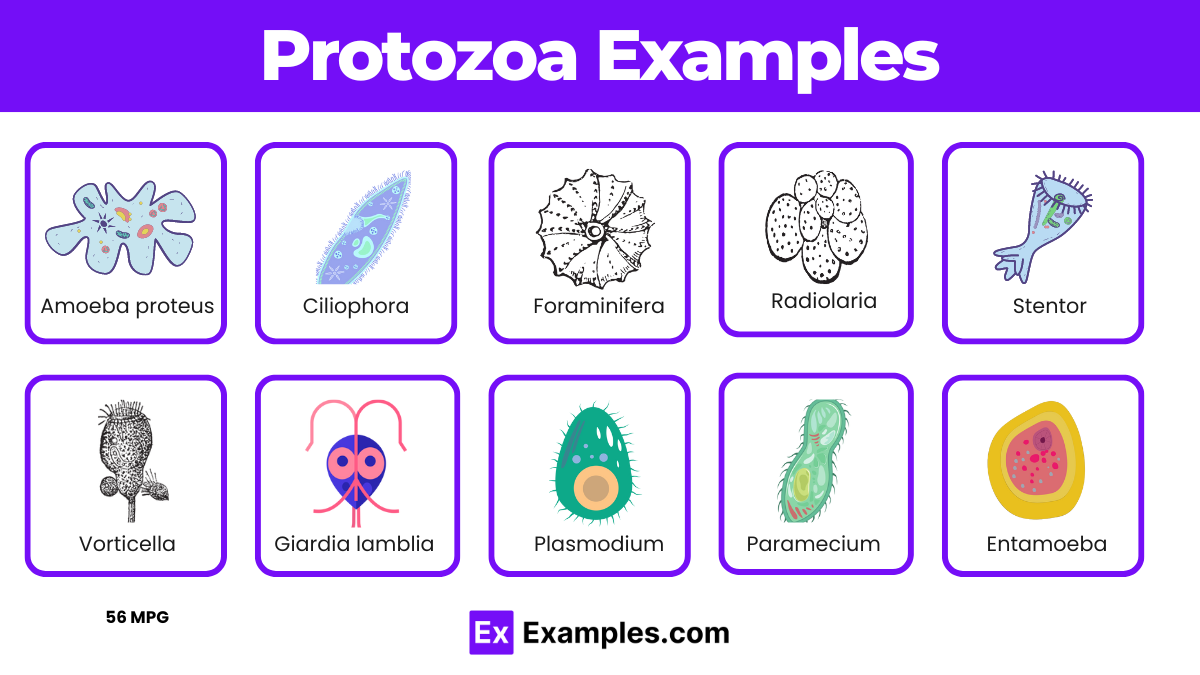What characteristic is used to classify protozoa?
Presence of cell walls
Mode of locomotion
Ability to photosynthesize
Multicellular organization


Protozoa are unicellular organisms belonging to the kingdom Protista. They are microscopic, diverse, and often found in aquatic environments. Protozoa can move using cilia, flagella, or pseudopodia, and they play essential roles in nutrient cycling and as predators of bacteria. Some protozoa are parasitic and can cause diseases in humans and animals. These single-celled organisms exhibit complex life cycles and are key to understanding ecological and biological processes.
Protozoa are single-celled eukaryotic microorganisms that belong to the kingdom Protista. They exhibit diverse forms and functions, living in various environments, including water and soil. Protozoa can be free-living or parasitic, and they often reproduce asexually through binary fission.

| Aspect | Protozoa | Bacteria |
|---|---|---|
| Cell Type | Eukaryotic (nucleus and membrane-bound organelles) | Prokaryotic (no nucleus, no membrane-bound organelles) |
| Cell Structure | Complex internal structure, larger size | Simple internal structure, smaller size |
| Reproduction | Asexual (binary fission, budding) and sexual (conjugation, syngamy) | Mainly asexual (binary fission), some sexual processes |
| Motility | Cilia, flagella, pseudopodia | Flagella, pili (some non-motile) |
| Habitat | Aquatic, soil, host organisms | Ubiquitous (everywhere: soil, water, extreme environments) |
| Diseases Caused | Malaria, Amoebiasis, Giardiasis, Trypanosomiasis, Toxoplasmosis, Leishmaniasis | Tuberculosis, Strep throat, E. coli infections, Cholera |
| Nutritional Mode | Heterotrophic, some autotrophic | Heterotrophic, autotrophic |
| Cell Wall | No cell wall, flexible membrane (some exceptions) | Peptidoglycan cell wall |
| Genetic Material | Linear chromosomes within a nucleus | Circular DNA in nucleoid |
| Size | Larger (typically 10-100 µm) | Smaller (typically 0.5-5 µm) |
Protozoa are found in various environments including water, soil, and inside host organisms.
Protozoa move using cilia, flagella, or pseudopodia.
No, not all protozoa are harmful; many play beneficial roles in ecosystems.
Protozoa reproduce both asexually (binary fission, budding) and sexually (conjugation, syngamy).
Yes, some protozoa can cause diseases such as malaria and amoebiasis.
Plasmodium, which causes malaria, is an example of a parasitic protozoan.
Most protozoa do not have a cell wall; they have a flexible cell membrane.
Protozoa typically range from 10 to 100 micrometers in size.
Protozoa can be either autotrophic or heterotrophic.
Protozoa obtain nutrients by ingesting other microorganisms or organic matter.
Text prompt
Add Tone
10 Examples of Public speaking
20 Examples of Gas lighting
What characteristic is used to classify protozoa?
Presence of cell walls
Mode of locomotion
Ability to photosynthesize
Multicellular organization
Which of the following is NOT a type of protozoan?
Amoeba
Paramecium
Euglena
Mushroom
What is the primary habitat of most protozoa?
Desert
Ocean
Freshwater
Mountains
How do protozoa primarily obtain their nutrients?
Photosynthesis
Absorption
Ingestion
Chemosynthesis
Which of the following protozoa is known for causing malaria?
Giardia
Plasmodium
Trypanosoma
Amoeba
What type of reproduction is commonly observed in protozoa?
Budding
Binary fission
Fragmentation
Sexual reproduction
Which structure in protozoa is used for locomotion and feeding?
Cell wall
Nucleus
Flagella
Chloroplast
What role do protozoa play in aquatic ecosystems?
Primary producers
Decomposers
Primary consumers
All of the above
Which of the following diseases is caused by a protozoan parasite?
Tuberculosis
Malaria
Influenza
Cholera
What is a common feature of the group called ciliates?
They have pseudopodia for movement
They have cilia covering their surface
They lack a defined nucleus
They reproduce only sexually
Before you leave, take our quick quiz to enhance your learning!

